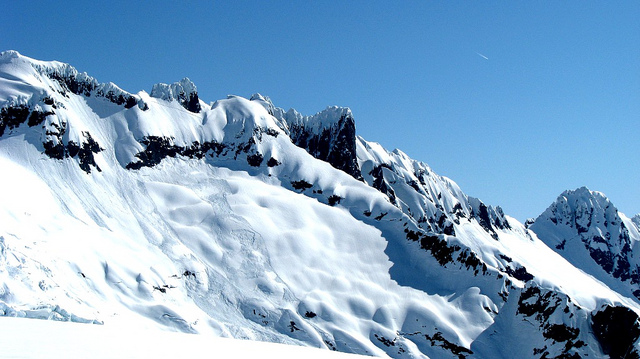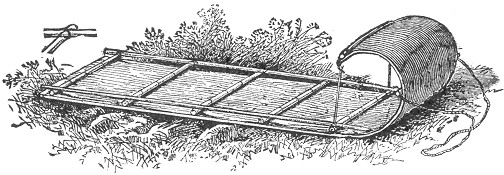|
1968 Biały Jar Avalanche
The avalanche in Biały Jar occurred on 20 March 1968, sweeping away 24 people who were walking along the bottom of in the Giant Mountains. Five of them, who were thrown aside by the avalanche, managed to survive. The remaining 19 people – including 13 Russians, 4 citizens of East Germany, and two Polish citizens – lost their lives. The rescue operation was conducted by the Polish Mountain Volunteer Search and Rescue, Czech rescuers, and volunteers. A total of 1,100 people took part in the operation. The last bodies of the victims were found only on 1 and 5 April. Origins and course The weather conditions during the first decade of March were relatively stable – no winds, high levels of sunshine, and temperatures around zero degrees. All of this contributed to the melting of a not very thick snow layer. The water from the melting snow seeped into the thick layer of ground (disintegrated granite rubble and some larger blocks). Additionally, the ground was soaked by the cr ... [...More Info...] [...Related Items...] OR: [Wikipedia] [Google] [Baidu] |
Avalanche
An avalanche is a rapid flow of snow down a Grade (slope), slope, such as a hill or mountain. Avalanches can be triggered spontaneously, by factors such as increased precipitation or snowpack weakening, or by external means such as humans, other animals, and earthquakes. Primarily composed of flowing snow and air, large avalanches have the capability to capture and move ice, rocks, and trees. Avalanches occur in two general forms, or combinations thereof: slab avalanches made of tightly packed snow, triggered by a collapse of an underlying weak snow layer, and loose snow avalanches made of looser snow. After being set off, avalanches usually accelerate rapidly and grow in mass and volume as they capture more snow. If an avalanche moves fast enough, some of the snow may mix with the air, forming a powder snow avalanche. Though they appear to share similarities, avalanches are distinct from slush flows, Mudflow, mudslides, Landslide#Debris landslide, rock slides, and serac collap ... [...More Info...] [...Related Items...] OR: [Wikipedia] [Google] [Baidu] |
Toboggan
A toboggan is a simple sled used in snowy winter recreation. It is also a traditional form of cargo transport used by the Innu, Cree and Ojibwe of North America, sometimes part of a dog train. It is used on snow to carry one or more people (often children) down a hill or other slope for recreation, or as a rescue sled. Designs vary from simple, traditional models to modern engineered composites. A toboggan differs from most sleds or sleighs in that it has no runners or skis (or only low ones) on the underside. The bottom of a toboggan rides directly on the snow. Some parks include designated toboggan hills where ordinary sleds are not allowed and which may include toboggan runs similar to bobsleigh courses. Toboggans can vary depending on the climate and geographical region. Such examples are Tangalooma (Australia) where toboggans are made from Masonite boards and used for travelling down steep sand dunes at speeds up to . Etymology The term toboggan likely comes from an ... [...More Info...] [...Related Items...] OR: [Wikipedia] [Google] [Baidu] |
1960s Disasters In Poland
Year 196 ( CXCVI) was a leap year starting on Thursday of the Julian calendar. At the time, it was known as the Year of the Consulship of Dexter and Messalla (or, less frequently, year 949 ''Ab urbe condita''). The denomination 196 for this year has been used since the early medieval period, when the Anno Domini calendar era became the prevalent method in Europe for naming years. Events By place Roman Empire * Emperor Septimius Severus attempts to assassinate Clodius Albinus but fails, causing Albinus to retaliate militarily. * Emperor Septimius Severus captures and sacks Byzantium; the city is rebuilt and regains its previous prosperity. * In order to assure the support of the Roman legion in Germany on his march to Rome, Clodius Albinus is declared Augustus by his army while crossing Gaul. * Hadrian's wall in Britain is partially destroyed. China * First year of the Jian'an Era, during the reign of the Xian Emperor of the Han. * The Xian Emperor returns to war-r ... [...More Info...] [...Related Items...] OR: [Wikipedia] [Google] [Baidu] |
1968 Disasters
Events January–February * January – The I'm Backing Britain campaign starts spontaneously. * January 5 – Prague Spring: Alexander Dubček is chosen as leader of the Communist Party of Czechoslovakia. * January 10 – John Gorton is sworn in as 19th Prime Minister of Australia, taking over from John McEwen after being elected leader of the Liberal Party the previous day, following the disappearance of Harold Holt. Gorton becomes the only Senator to become Prime Minister, though he immediately transfers to the House of Representatives through the 1968 Higgins by-election in Holt's vacant seat. * January 15 – The 1968 Belice earthquake in Sicily kills 380 and injures around 1,000. * January 21 ** Vietnam War: Battle of Khe Sanh – One of the most publicized and controversial battles of the war begins, ending on April 8. ** 1968 Thule Air Base B-52 crash: A U.S. B-52 Stratofortress crashes in Greenland, discharging 4 nuclear bombs. * January 23 – North Ko ... [...More Info...] [...Related Items...] OR: [Wikipedia] [Google] [Baidu] |


